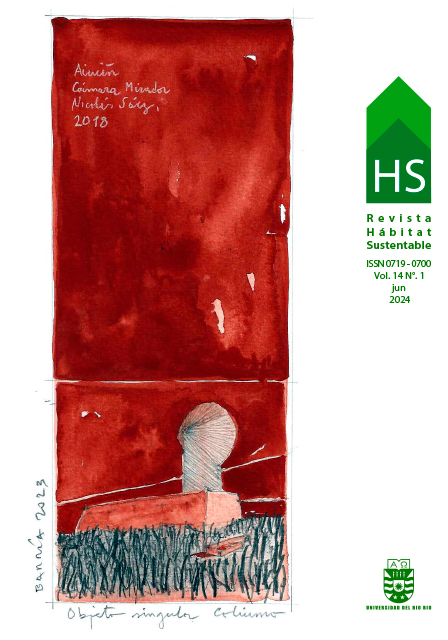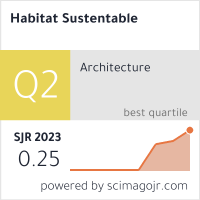Un análisis del impacto de la certificación EDGE en edificaciones: el caso de Perú
DOI:
https://doi.org/10.22320/07190700.2024.14.01.05Palabras clave:
EDGE, edificaciones verdes, eficiencia energética, sustentabilidadResumen
Las certificaciones ambientales, se han implementado en el sector de la construcción por los beneficios de reducción del impacto ambiental, mejora de la eficiencia energética, uso de agua, entre otros. En ese sentido, en los últimos años se ha adoptado en más de ciento cuarenta países la certificación EDGE (Excellence in Design for Greater Efficiencies). Sin embargo, pese a su popularidad; la literatura sobre los impactos en el medio ambiente, es escasa a nivel mundial y latinoamericano. Por ello, el siguiente artículo analizará el uso de EDGE en proyectos de vivienda en el Perú y mostrará las estrategias empleadas en los casos de estudio para disminuir el impacto ambiental. Para ello, se realiza una revisión literaria de EDGE y un análisis de dieciocho proyectos de edificaciones peruanos, los principales ahorros promedio obtenidos, son: 27.6% en Energía, 41.2% en Agua y 51.81% en Carbono Incorporado en Materiales. El siguiente estudio significa un aporte a los profesionales del sector construcción interesados en implementar la certificación EDGE en sus proyectos, ya que se evidencian los impactos ambientales que genera este tipo de certificación.
Descargas
Citas
AGYEKUM, K., AKLI-NARTEY, E. E. K., KUKAH, A. S., y AGYEKUM, A. K. (2023). Importance-performance analysis (IPA) of the indoor environmental quality (IEQ) of an EDGE-certified building in Ghana. International Journal of Building Pathology and Adaptation, 41(1), 73–95. https://doi.org/10.1108/IJBPA-03-2021-0040
AINI, T. N., y TARIGAN, S. G. (2023). Analysis of the EDGE Rating System Implementation in PKN STAN Buildings. Architectural Research Journal (ARJ), 3(2), 46–49. https://doi.org/10.22225/arj.3.2.2023.46-49
ATOLAGBE, U. K., SALIHU, A., MAMBO, A. D., y KUMAR, E. (2023). Accounting of Carbon Footprint and Energy Consumption of Nile University in Nigeria: A detailed and Systematic Approach. 2023 2nd International Conference on Multidisciplinary Engineering and Applied Science (ICMEAS), 1, 1–5. https://doi.org/10.1109/ICMEAS58693.2023.10379409
AYANRINDE, O., y MAHACHI, J. (2023). Scenario Method for Catalysing Circularity and Lowering Emissions in the Construction Sector/Real Estate, Nigeria (pp. 388–402). https://doi.org/10.4324/9781003267492-22
AZOUZ, M., y ELARIANE, S. (2023). Towards energy efficiency: retrofitting existing office buildings using smart technologies. Journal of Engineering and Applied Science, 70(1), 147. https://doi.org/10.1186/s44147-023-00327-0
BELTRÁN-MÉNDEZ, O., y NIK-BAKHT, M. (2018). Can “EDGE” be the Solution to Sustainability of Buildings in Colombian Market? In Construction Research Congress 2018 (pp. 246–256). https://doi.org/10.1061/9780784481301.025
BOCHARE, R., y BAGORA, P. (2022). Comparative Analysis of Green Building Rating Systems for Residential House: A Case Study. ECS Transactions, 107(1), 7091. https://doi.org/10.1149/10701.7091ecst
CAO, Y., KAMARUZZAMAN, S. N., y AZIZ, N. M. (2022a). Green Building Construction: A Systematic Review of BIM Utilization. Buildings, 12(8). https://doi.org/10.3390/buildings12081205
Cao, Y., Xu, C., Kamaruzzaman, S. N., y Aziz, N. M. (2022b). A Systematic Review of Green Building Development in China: Advantages, Challenges and Future Directions. Sustainability, 14(19). https://doi.org/10.3390/su141912293
CCCS (Consejo Colombiano de Construcción Sostenible). (2024). Caso de negocio LEED en Latinoamérica. https://www.cccs.org.co/wp/mitigacion/caso-de-negocio-de-leed-en-latinoamerica/
CHAVEZ-FINOL, F., TREBILCOCK-KELLY, M., y PIDERIT-MORENO, M. B. (2021). Diseño de edificios de oficinas sustentables para promover ocupantes sustentables. Hábitat Sustentable, 11(2), 34–45. https://doi.org/10.22320/07190700.2021.11.02.03
DLAMINI, L. N., y YESSOUFOU, K. (2022). Residents and Professionals’ Perspectives on Energy and Water Consumption While Transiting from Conventional to Sustainable Housings in South Africa. Sustainability, 14(8). https://doi.org/10.3390/su14084498
DOAN, D. T., GHAFFARIANHOSEINI, A., NAISMITH, N., ZHANG, T., GHAFFARIANHOSEINI, A., y TOOKEY, J. (2017). A critical comparison of green building rating systems. Building and Environment, 123, 243–260. https://doi.org/https://doi.org/10.1016/j.buildenv.2017.07.007
Edge Buildings. (2024). Archivo de estudios de proyectos y Nuevos estudios de proyectos. https://edgebuildings.com/project-studies/
ELKHAPERY, B., KIANMEHR, P., y DOCZY, R. (2021). Benefits of retrofitting school buildings in accordance to LEED v4. Journal of Building Engineering, 33, 101798. https://doi.org/https://doi.org/10.1016/j.jobe.2020.101798
IBRAHIM, H., SALAHELDIN ELSAYED, M., SEDDIK MOUSTAFA, W., y MOHAMED ABDOU, H. (2023). Functional analysis as a method on sustainable building design: A case study in educational buildings implementing the triple bottom line. Alexandria Engineering Journal, 62, 63–73. https://doi.org/https://doi.org/10.1016/j.aej.2022.07.019
IFC (International Finance Cooperation). (2021). Guía del usuario de EDGE Versión 3.0. https://edgebuildings.com/wp-content/uploads/2022/07/2022001613SPAspa001.pdf?lang=es
INDRIYATI, C., y IZZAH, S. (2022). Water Tower Conservation and Sriwijaya University Law Efficiency Based on Indonesian Green Building Certification. Journal of Applied Science, Engineering, Technology, and Education, 4(2 SE-Articles), 176–182. https://doi.org/10.35877/454RI.asci99713
ISIMBI, D., y PARK, J. (2022). The Analysis of the EDGE Certification System on Residential Complexes to Improve Sustainability and Affordability. Buildings, 12(10). https://doi.org/10.3390/buildings12101729
KAPOOR, P., SABERI, O., y OLIVER, N. (2019). Green Urban Development: A methodology to calculate site and infrastructure related GHG emissions. IOP Conference Series: Earth and Environmental Science, 297(1), 12004. https://doi.org/10.1088/1755-1315/297/1/012004
KARTIKASARI, F. D., TARIGAN, E., FRANSISCUS, Y., y LIDYAWATI, T. (2018). Energy Saving Measures and Potential of Energy Efficiency at the University of Surabaya, Based on EDGE Simulation. In 2018 5th International Conference on Information Technology, Computer, and Electrical Engineering (ICITACEE), (pp. 89–92). https://doi.org/10.1109/ICITACEE.2018.8576925
Li, C. Z., ZHAO, Y., y XU, X. (2019). Investigation of dust exposure and control practices in the construction industry: Implications for cleaner production. Journal of Cleaner Production, 227, 810–824. https://doi.org/https://doi.org/10.1016/j.jclepro.2019.04.174
MARZOUK, O. A. (2023). Zero Carbon Ready Metrics for a Single-Family Home in the Sultanate of Oman Based on EDGE Certification System for Green Buildings. Sustainability, 15(18). https://doi.org/10.3390/su151813856
ONUDI. (2021). Industrial Development Report 2022. The Future of Industrialization in a Post-Pandemic World. Overview. https://www.unido.org/sites/default/files/unido-publications/2023-03/IDR-2022-OVERVIEW-es.pdf
REGALADO-ESPINOZA, M., MANRIQUE, J. G., LOREÑA, M. H., COZ, G. L., MACHACA, Á. M., VALDIVIA, R. M., VARILLAS, C. N., ANDIA, C. Q., y ASTO, D. R. (2021). An Analysis of Leed Certification’s Adaptation to Design and Construction of Sustainable Buildings in Peru [Discurso principal]. 2021 Congreso Internacional de Innovación y Tendencias En Ingeniería (CONIITI), Colombiahttps://doi.org/10.1109/CONIITI53815.2021.9619628
RODRÍGUEZ, A. M., FERNÁNDEZ, A. C. R., ROJAS, L. V, PALMA, F. P., y OLIVEROS, A. B. (2021). State of regulation and implementation of energy and water-saving measures in buildings in Colombia. IOP Conference Series: Earth and Environmental Science, 871(1), 12008. https://doi.org/10.1088/1755-1315/871/1/012008
SABERI, O., y KAPOOR, P. (2016). Virtual energy for comfort: To present discomfort and reward passive design in EDGE. Proceedings - 9th International Windsor Conference 2016: Making Comfort Relevant, April, 1325–1332.
SAMAMÉ-ZEGARRA, E. K. (2021). Water Efficiency Evaluation Analysis Among Environmental Certification Methods: LEED, BREEAM, DGNB, HQE, EDGE, and BONO VERDE. In R. González-Lezcano (Ed.), Advancements in Sustainable Architecture and Energy Efficiency (pp. 275–291). IGI. https://doi.org/10.4018/978-1-7998-7023-4.ch013
SETYOWATI, D. L., TRIHATMOKO, E., WIJAYANTO, P. A., y AMIN, M. (2020). Simulating water efficiency management at UNNES Campus, Semarang, Indonesia using EDGE application. IOP Conference Series: Earth and Environmental Science, 485(1), 12038. https://doi.org/10.1088/1755-1315/485/1/012038
TARIGAN, E., y KARTIKASARI, F. D. (2016). Simulation of Energy Savings in a Six Floor Library Building University of Surabaya. 3rd Engineering Science and Technology International Conference, 1–4. https://repository.ubaya.ac.id/28481/
VELÁZQUEZ ROBLES, J. F., PICÓ, E. C., y HOSSEINI, S. M. A. (2022). Environmental performance assessment: A comparison and improvement of three existing social housing projects. Cleaner Environmental Systems, 5, 100077. https://doi.org/https://doi.org/10.1016/j.cesys.2022.100077
VILLASEÑOR, M. (2021). Breve Informe estado de certificaciones de sustentabilidad en la construcción países CEELA. https://proyectoceela.com/wp-content/uploads/2023/01/20210430_Outcome-3_Estado-Certificaciones-Paises-CEELA.pdf
Descargas
Publicado
Cómo citar
Número
Sección
Licencia
Derechos de autor 2024 Monica J. Condezo-Solano, Andrews Alexander Erazo-Rondinel, Lorena Milagros Barrozo-Bojorquez, Coraima Chantal Rivera-Navarrete, Areli Zaraida García-Puclla

Esta obra está bajo una licencia internacional Creative Commons Atribución-CompartirIgual 4.0.
El contenido de los artículos que se publican en cada número de Hábitat Sustentable, es responsabilidad exclusiva de los autores y no representan necesariamente el pensamiento ni comprometen la opinión de la Universidad del Bío-Bío.
Los autores/as conservarán sus derechos de autor y garantizarán a la revista el derecho de primera publicación de su obra, el cuál estará simultáneamente sujeto a la Licencia de Reconocimiento de Creative Commons CC BY-SA que permite a otros compartir-copiar, transformar o crear nuevo material a partir de esta obra con fines no comerciales, siempre y cuando se reconozcan la autoría y la primera publicación en esta revista, y sus nuevas creaciones estén bajo una licencia con los mismos términos.











 Programa de Información Científica/Concurso Fondos de Publicación de Revistas Científicas 2018/ Proyecto Mejoramiento de Visibilidad de Revistas UBB (Código:FP180007)
Programa de Información Científica/Concurso Fondos de Publicación de Revistas Científicas 2018/ Proyecto Mejoramiento de Visibilidad de Revistas UBB (Código:FP180007) 





